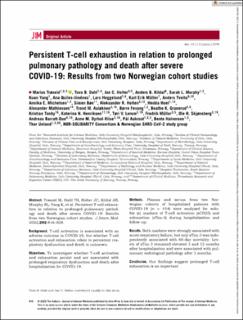| dc.contributor.author | Trøseid, Marius | |
| dc.contributor.author | Dahl, Tuva Børresdatter | |
| dc.contributor.author | Holter, Jan Cato | |
| dc.contributor.author | Kildal, Anders Benjamin | |
| dc.contributor.author | Murphy, Sarah Louise Mikalsen | |
| dc.contributor.author | Yang, Kuan | |
| dc.contributor.author | Quiles Jimenez, Ana Maria Teresa | |
| dc.contributor.author | Heggelund, Lars | |
| dc.contributor.author | Muller, Karl Erik | |
| dc.contributor.author | Tveita, Anders Aune | |
| dc.contributor.author | Michelsen, Annika Elisabet | |
| dc.contributor.author | Bøe, Simen | |
| dc.contributor.author | Holten, Aleksander Rygh | |
| dc.contributor.author | Hoel, Hedda Benedicte | |
| dc.contributor.author | Mathiessen, Alexander | |
| dc.contributor.author | Aaløkken, Trond Mogens | |
| dc.contributor.author | Fevang, Børre | |
| dc.contributor.author | Granerud, Beathe Kiland | |
| dc.contributor.author | Tonby, Kristian | |
| dc.contributor.author | Nezvalova-Henriksen, Katerina | |
| dc.contributor.author | Lerum, Tøri Vigeland | |
| dc.contributor.author | Müller, Fredrik | |
| dc.contributor.author | Skjønsberg, Ole Henning | |
| dc.contributor.author | Barratt-Due, Andreas | |
| dc.contributor.author | Riise, Anne Margarita Dyrhol | |
| dc.contributor.author | Aukrust, Pål | |
| dc.contributor.author | Halvorsen, Bente Evy | |
| dc.contributor.author | Ueland, Thor | |
| dc.date.accessioned | 2022-10-19T09:41:10Z | |
| dc.date.available | 2022-10-19T09:41:10Z | |
| dc.date.created | 2022-08-22T15:20:20Z | |
| dc.date.issued | 2022 | |
| dc.identifier.issn | 0954-6820 | |
| dc.identifier.uri | https://hdl.handle.net/11250/3026999 | |
| dc.description.abstract | Background: T-cell activation is associated with an adverse outcome in COVID-19, but whether T-cell activation and exhaustion relate to persistent respiratory dysfunction and death is unknown.
Objectives: To investigate whether T-cell activation and exhaustion persist and are associated with prolonged respiratory dysfunction and death after hospitalization for COVID-19.
Methods: Plasma and serum from two Norwegian cohorts of hospitalized patients with COVID-19 (n = 414) were analyzed for soluble (s) markers of T-cell activation (sCD25) and exhaustion (sTim-3) during hospitalization and follow-up.
Results: Both markers were strongly associated with acute respiratory failure, but only sTim-3 was independently associated with 60-day mortality. Levels of sTim-3 remained elevated 3 and 12 months after hospitalization and were associated with pulmonary radiological pathology after 3 months.
Conclusion: Our findings suggest prolonged T-cell exhaustion is an important immunological sequela, potentially related to long-term outcomes after severe COVID-19. | en_US |
| dc.language.iso | eng | en_US |
| dc.publisher | Wiley | en_US |
| dc.rights | Attribution-NonCommercial-NoDerivatives 4.0 Internasjonal | * |
| dc.rights.uri | http://creativecommons.org/licenses/by-nc-nd/4.0/deed.no | * |
| dc.title | Persistent T-cell exhaustion in relation to prolonged pulmonary pathology and death after severe COVID-19: Results from two Norwegian cohort studies | en_US |
| dc.type | Journal article | en_US |
| dc.type | Peer reviewed | en_US |
| dc.description.version | publishedVersion | en_US |
| dc.rights.holder | Copyright 2022 the authors | en_US |
| cristin.ispublished | true | |
| cristin.fulltext | original | |
| cristin.qualitycode | 2 | |
| dc.identifier.doi | 10.1111/joim.13549 | |
| dc.identifier.cristin | 2045042 | |
| dc.source.journal | Journal of Internal Medicine | en_US |
| dc.source.pagenumber | 816-828 | en_US |
| dc.identifier.citation | Journal of Internal Medicine. 2022, 292 (5), 816-828. | en_US |
| dc.source.volume | 292 | en_US |
| dc.source.issue | 5 | en_US |

